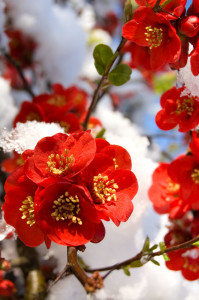Metal Garden Markers Can Distinguish Where Your Winter Garden Plants Are Located…Even When the Snow is Falling
 You may be gathering in those last few juicy tomatoes from your garden – especially this year when early summer rains delayed much of summer’s produce in some parts of the country. Soon it will be time to cut down the garden and turn the soil. But, before you tuck your gardening tools into bed for the winter, consider trying your hand at some winter gardening. With protected planting boxes, a trowel, straw and some metal garden markers, you could still be gardening even when snowflakes start to paint the landscape a cottony white.
You may be gathering in those last few juicy tomatoes from your garden – especially this year when early summer rains delayed much of summer’s produce in some parts of the country. Soon it will be time to cut down the garden and turn the soil. But, before you tuck your gardening tools into bed for the winter, consider trying your hand at some winter gardening. With protected planting boxes, a trowel, straw and some metal garden markers, you could still be gardening even when snowflakes start to paint the landscape a cottony white.
Some Like it Hot – Some Like it Cool
Not every delicious garden vegetable is a heat-worshipper. There are plenty of sweet and scrumptious vegetables that actually prefer the cool. No plants can survive freezing, but with a little protective care, you can nurture lettuces, broccoli, spinach, carrots and more in the midst of those dark, snowy winter months. Just imagine it.
How to Get Started
Now is the time to get some planting beds ready for this gardening adventure. You’ll want your plants to be well on their way before temperatures really start to plunge. One or two raised wooden beds is all the space you’ll need to begin. If you use soil from your summer garden, be sure to liven it up with some fresh compost. Also, to protect the soil from freezing when things get truly frigid, try lining your box with straw or tuck some heavy blankets underneath and around the box. Cool weather plants don’t need heat, but freezing may kill them.
Frozen May be a Popular Movie, But Plants Don’t Like Freezing Weather
You can start your plants inside now labeled with metal garden markers and then move them to your planting boxes once they’ve gotten a solid start. As long as days are sunny and dry – go ahead and leave the planting box lids open to the fresh air. You can do this even in the deepest days of winter so long as the temperature is above freezing. When the thermometer says freezing, keep your boxes snuggled in straw and wrapped in cozy blankets. You could choose to place your boxes near the house to gain a bit of radiant heat all winter.
It’s true that once deep winter arrives, your plants will go dormant so you won’t actually see them growing. But until then you can pluck fresh lettuce, spinach, arugula, cabbage, mustard, broccoli and so on. Then, next spring, you will have a great head start for the cool, pre-summer garden. If you live in a temperate climate, you could actually grow and harvest all winter long. But for those living in cold areas, winter gardening can extend the vegetable growing season and provide a jump for the following spring.
You can find instructions on how to build your planting boxes in books or online. For the best metal garden markers, Kincaid Plant Markers provides top quality markers season after season. Order yours today and start your own winter garden adventure.

Identify Your Plants in an Indoor Garden This Winter With Quality Markers | Kincaid Plant Markers
[…] year. Indoor gardening can provide you with your own fresh vegetables year round. Just be sure to identify your plants so that you give them the amount of water and light each one […]